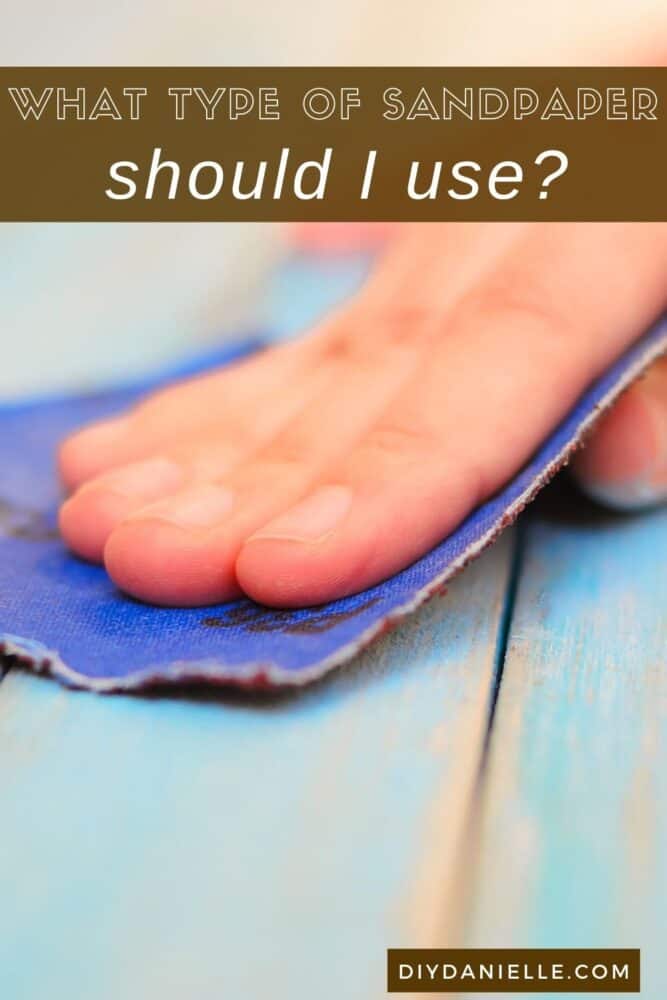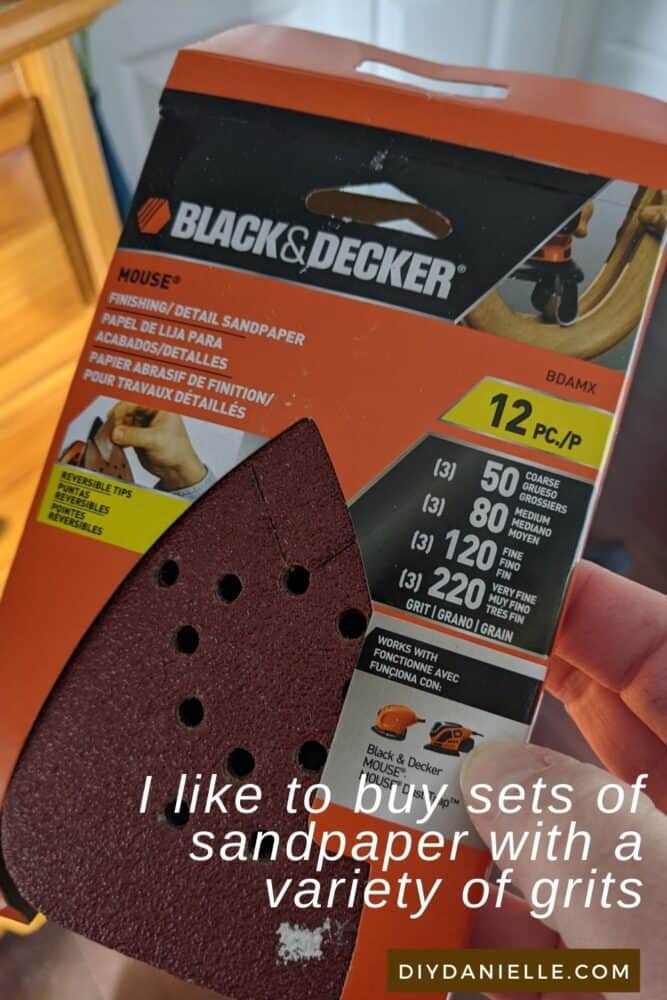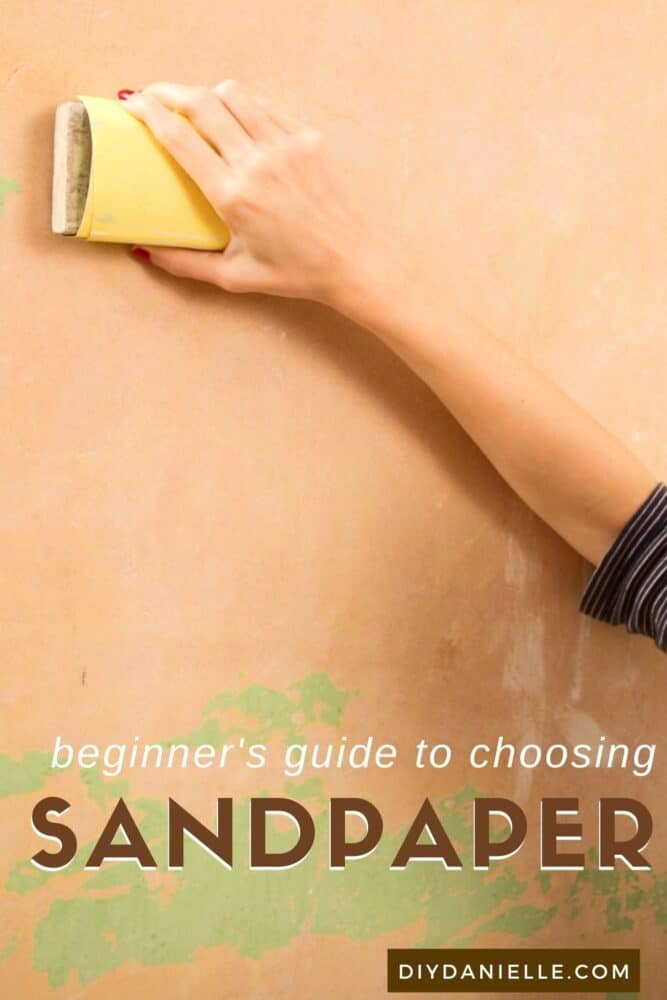
Types of sandpaper: Everything you need to know about sandpaper and how to choose the right type for your DIY project.
This post may contain affiliate links which may earn me commissions should you click through them and take certain actions. As an affiliate for Amazon, Cricut, xTool, Home Depot, and other sites, I earn from qualifying purchases. Please DIY carefully. View my full legal disclosures here.
Please read the whole post so you don’t miss any important information!
A sander will only be as good as the type of sandpaper you are using for your wood project. Not only is it important to choose the right sander, but you also need to select the sandpaper that can adequately complete the task at hand. Choosing the right sandpaper can be overwhelming if you don’t know the difference between each kind.
This guide will explain the variations in sandpaper and how to select which one will work best for your next DIY project.
How Sandpaper is Made
A common misnomer is that sandpaper is made up of grains of sand. Instead, it is actually created from particles of abrasive materials such as aluminum oxide or garnet. These particles are sifted through a filter in order to sort the large pieces from the smaller ones. Then, the sorted sizes are adhered to a paper, sponge, or cloth backing. The abrasive materials are sharp, which allows it to make small shavings out of the wood, smoothing the surface or removing excess layers.
Grit Levels
The different sized particles that make up each type of sandpaper is what gives the value of the grit. The Coated Abrasive Manufacturers Institute (CAMI) has established a standard for where a particular grit lies within a graduation scale. The number is an indication of the quantity of holes in the screens used to filter the grains during manufacturing.
The higher the number, the smaller each particle, and the finer the grit of the sandpaper will be. On the contrary, lower numbers indicate larger particles and a coarser grit. The numerical range for grit is anywhere from 16 to 600.
Categories of Coarseness
To make it easier to identify the level of coarseness associated with the grit number, manufacturers also give a word description to establish how rough the paper will be. The grit numbers are placed into broader categories of coarseness so that the buyer can know what sandpaper to select according to their project. The levels of coarseness are included below:
Super Fine Sandpaper
Super fine is typically composed of grits that are numbered 320 and above. This type of sandpaper is useful for polishing hard materials; for example, stone, plastics, or ceramics.
Very Fine Sandpaper
The grit in this category ranges from 220 to 280. It is best for sanding between coats of paint or varnish.
Fine Sandpaper
This level of coarseness is often best when you need to smooth bare wood. It ranges from 120 to 180.
Medium Sandpaper
When you need to shape wood or perform the first sanding on soft woods, medium sandpaper is a good choice. The grit value is 60-100.
Coarse Sandpaper
For coarse sandpaper, the range is smaller and only goes from 40 to 50. I can be used to remove paint or for other rough sanding jobs.
Very Coarse Sandpaper
This is often the first sandpaper used on the sanding of bare wood floors. The grit number is 30 to 36.
Extra Coarse Sandpaper
When working with a sanding machine on painted or finished floors, this is typically the type of sandpaper used. It ranges from 12-20 in grit.
It is common to start with a coarser sandpaper and then slowly transition to a finer to ensure a better finish.
Types of Abrasive Materials
When deciding which sandpaper to use for your project, it is important to consider the grit as well as the type of abrasive material used. Each material is different and will produce a distinct result when it makes small shavings in the wood.
Here is a description of various types of abrasive materials and the advantages of each:
Aluminum Oxide
This is a durable synthetic material that works well for all types of sanding. It is especially good at sanding woods and metals, particularly bronze and alloy steel. Aluminum oxide is most effective when it is used on a power sander. Because it is brittle, the outer layers will crumble up and fall off. This allows it to last for a long time as it continuously creates new edges.
Ceramic
Ceramic is a synthetic material and can be more expensive than other kinds of sandpapers. It is typically used for rough sanding because of its hard and durable texture. You will need to use a power sander with this type of sandpaper to make it work effectively.
Garnet
A natural material, garnet is one of the softer grains used to make sandpaper. Because of this, it only works well with fine sanding. It may wear out fast, but it also creates a very smooth surface. If you are using a manual sander, this sandpaper is a good option.
Emery
Emery is a very sharp material, so does not usually deliver good results when working with wood. It is natural and commonly used to remove corrosion or polish on metals.
Flint
This is a natural material and one of the most affordable types of sandpaper. It works best for sanding off paint or varnish, or when you have a rough, but small, project. Flint sandpaper is not commonly used.
Silicon Carbide
A key benefit to this sandpaper is that it can be used on wet or dry surfaces. It is one of the most durable types of synthetic sandpapers. It can actually sharpen itself on hard materials such as metal or plastic. Its most common use is polishing or sanding between applications of paint.
Zirconia Alumina
This is a very tough synthetic material. It can perform jobs such as shaving down rough edges on metal or as the first round of sanding on rough wood. Similar to silicon carbide, it also sharpens itself as it sands. This sandpaper material will last for a long time.
Kinds of Sandpaper Coatings
In the process of sanding, friction is created between the wood and the grains while making shavings. This friction causes heat, which can lead to melting of the resin in wood and clogging of the sandpaper. If you are having to constantly replace clogged pieces of sandpaper, this could lead to an uneven finish. For this reason, the coating can be very important to the quality of a type of sandpaper. It can help the sandpaper to last longer and produce better results.
The differences in sandpaper coatings are based on the amount of space left between the particles of abrasive material. Less space leads to the retention of heat and a greater probability that the resin will get stuck and clog the sandpaper. More space creates room for air flow and allows any resin to fall off instead of remaining between the grains.
Overall, there are three different kinds of sandpaper coatings, explained below:
Closed Coat
This is the highest level of grain coverage, ranging from 90-95% of coverage on the paper. A closed coat is typical with coarser grains because it works best for rough sanding projects. You will want to use this coating for the first sanding on a raw wood piece. Other projects that will benefit from a closed coat include grinding hard metals or on sealers and lacquers. This will produce a uniform scratch pattern with a high quality finish.
Semi-Open Coat
The semi-open coat is a step down from the closed coat. It is recommended for working with hard woods when they are still in the raw wood stage.
Open Coat
Grains will only cover around 60-65% of the surface of an open coat sandpaper. If you are working with a softer wood that has more resin, you will want to use an open coat. It will clog less frequently and lead to a smoother finish than the other kinds of coatings.
When choosing a sandpaper for your next DIY project, you will need to consider the type of material you will be working with, the size and shape of the product, and the desired finish you would like to create.
With these aspects in mind, you can select a sandpaper with the coarseness, material, and coating that will produce the best results.
Personally, I like to buy variety packs of grit that match my sander. This is a good example of one pack for my mouse sander.

If you need help choosing the right sander, check out my post on Types of Sanders and Their Uses.
Please share and pin this post! If you make this project, share it in our Stuff Mama Makes Facebook Group. We have regular giveaways for gift cards to craft stores. You can also tag me on Instagram @doityourselfdanielle; I love seeing everything you make!



doc
Sunday 19th of March 2023
thanks for the sandpaper education - informative without being to verbose.
Hejianzhong
Monday 26th of September 2022
Hello, we are a Chinese factory that has been producing sandpaper for 25 years, and we have cheap and high-quality products. I saw on the website that your company is a very good sandpaper dealer, and I hope to cooperate with you. If possible, we will send free samples for you to choose